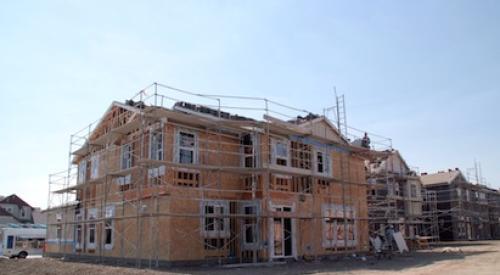This year, Ford will produce more than a half-million F-150 pickups, the largest-selling vehicle in the U.S. for 29 consecutive years and the best-selling truck for 35 years. Ford wins every quality award and is very profitable.
Imagine if in mid-February Ford was on truck number 50,000, only 10 percent into the 2011 production run, and they did not have final plans, specifications, options, component costs, and contracts signed. Preposterous, right? That nice $10 billion profit Ford made in 2010 would quickly go up in smoke. Yet in home building, it is almost standard operating procedure to not have these items nailed down even way beyond 10 percent of a community build-out for production building, or 10 percent of a custom home. Why? Does it really have to be, “that’s just home building”?
Now envision that instead of a steady flow on the line, Ford would start 100 trucks today, zero tomorrow, 20 the next day, 10 the day after, and 175 the following day. Imagine that the materials arrived in a haphazard fashion, placed wherever they would fit around the line that day, and that there was no incoming-parts verification or quality audit. Finally, picture a line with customers making changes to their trucks after they had already started down the line. A production disaster would ensue and costs would skyrocket. Instead, what you see is a steady pace of production, regardless of the volume, with all details nailed down up front and all materials verified for quantity and quality, and delivered to the right place at the right time.
Sure, building trucks is different from building houses, but not as different as we think, and not as different as we make it. In the truck category, Ford has cracked the code on quality, productivity, and profit, surpassing even Toyota in this arena, and we’d do well to heed their lessons. Can we make the translation?
Scheduling As a Way to Create Order From Chaos
Back in the glory days of 1991-2006, when so much of the money was made on land appreciation, sales price inflation, and volume expansion, production was a mere afterthought compared with finance, sales, and land development. Put some money together, buy plans, build something—anything—and a buyer was waiting. Those days are gone. And, as we established in my articles on Lean Operations, we have to learn to make money on the house itself. So much of that knowledge, though, is now gone from the industry, either retired or just moved on. You can’t just write a memo to the troops demanding that they “start building profitably!” We need an anchor, a theme, an “idee fixe,” which Merriam-Webster defines as an “idea that dominates one’s thinking for a prolonged period—an obsession.” We need to learn again how to be great builders of product.
If you know Dr. W. Edwards Deming’s teachings, you know he'd approve of one important clarification to his quote: “Uncontrolled variation is the enemy of quality and profit.” Unfortunately, uncontrolled variation is legion in home building.
Dr. W. Edwards Deming, the planet’s foremost quality guru, who died shortly after his 93rd birthday in 1993, is quoted as having said, “Variation is the enemy of quality.” I heard Deming speak numerous times in front of large groups and sat with him in small, more intimate settings. In his later years, he added a critical distinction to that quote, saying, “Uncontrolled variation is the enemy of quality.” This is a key point for home builders: You can have all the variation you like, offer customers any option, any change (cosmetic, structural, or otherwise), provided you have a system that keeps that variation under control during production.
If you know Deming’s teachings, you know that he would approve of one important clarification to his quote: “Uncontrolled variation is the enemy of quality and profit.”
Unfortunately, uncontrolled variation is legion in home building, and it has only gotten worse in this economy. How do we control this variation that seems endemic to our business? How do we rein in the mistakes, errors, rework, bloated schedules — the chaos that saps our energy and depletes our margins? The key is schedule. To get schedule right, you have to do so many other things well that schedule serves as the perfect anchor for your Lean operating journey.
Home building is a never-ending struggle to bring order from chaos. Compared with the typical manufacturing operation, the home building factory moves continually and the workers shift from site to site, sometimes working at multiple worksites weekly or even daily. Most builders have far more plans than they need and too many options. They allow customers to make changes far too late in the process and convince themselves that they have to do it to sell homes. The result is scheduling on the fly, where field superintendents call trades the week before or even the day prior to arriving at a site, or even worse, trades have to check every site to see if it’s ready. That’s total waste and that’s not Lean.

25 Things the Finest Home Builders Do
After three decades of working with home builders in the U.S., Canada, and Australia, there is one inviolate rule that I have found: The best builders are the best schedulers. What follows is a list of what the finest builders do well—not always perfectly, but clearly better than their competitors. As one builder pointed out, you can still schedule well without meeting some of these principles, but for each one you skip, it makes having a predictable, airtight schedule more difficult.
1. Adopt simplification as a daily company mantra, no matter the size or type of product. Simplification is not just the domain of the box-on-box production units; it applies equally to large custom homes and everything in between. Whether product or process, eliminating excess steps, paperwork, approvals, materials, or trips makes scheduling far easier.
2. Develop a thorough “start requirements” checklist for each project and follow it religiously. This covers everything that must be done at a project site before you dig so the house has a fighting chance to stay on schedule — undergrounds, grading, lot/pad prep, lot-fit analysis, permits, etc.
3. Include “meet customer” activities in the schedule, including pre-build, pre-drywall, and orientation. Don’t pretend that these critical activities don’t take time or can simply be scheduled on the fly. Careful management of the customer relationship and what goes into their home avoids changes that can upset the schedule.
4. Recruit suppliers and trades that understand that a fast, consistent schedule is in their best interest. Sure, some won’t get it, but most can understand that a predictable schedule with long lead times makes everything they do easier and allows them to stay on time for you. The prospect of getting paid more quickly is usually enough motivation.
5. Establish clear scopes of work for each supplier and trade with job-ready and job-complete definitions. Every single item and how it is done should show up on someone’s scope, as should a clear definition of “job complete.” If not, things get missed and the chain of phone calls, extra trips, and trades on top of other trades begins. The schedule suffers.
6. Develop your schedule with input from each supplier and trade, with realistic allowances for weather, holidays, etc. If you’re in Fargo, N.D., don’t pretend you have the same number of workdays in February that you do in July. If you’re in Michigan, be a realist and take two days out in November for deer hunting season. Never schedule beyond the capacity of the workforce, and you must build a relationship where your trades are completely honest with you. Getting them involved gets buy-in.
7. All units, regardless of size, should be built on the same schedule, with specific tasks completed on specific days. For instance, framing always begins on day 12. Insulation goes in on day 30. Flooring begins on day 49 — every house, every time (note: sample numbers only). While controversial, this is the ideal. Sure, you will have down days on your smaller plans, but overall, your schedule will dramatically improve and shorten. The goal is total predictability.
8. Adapt crew sizes to schedule. Never schedule based on crew size and availability. An 1800-square-foot ranch might take a four-man framing crew five days. To frame a 3,000-square-foot, two-story house, you may need a crew of eight to meet that same five-day schedule window. Find trades who can adapt and give them steady business.
9. Establish a system for weather events and other contingencies. The goal is to keep the entire system working in harmony, maintaining flow and predictability throughout the process. If a weather event occurs, move all houses back a day (or whatever is required). By doing so, you just eliminated overlaps and trade conflict. Every space launch builds in automatic holds to cushion delays. Most get used, but the launch is still “on time.”
10. Value-engineer all plans based on Lean design principles prior to start. The goal is to have as close to the exact material requirements delivered to the house as possible, with no excess supply or shortages—no TJIs to pick up, no cubes of brick left over, no sheets of OSB for a hot-shot run. Every single incident compromises the schedule.
11. Use manufactured components whenever available and cost-effective, including trusses, panels, and off-site sub-assemblies. Manufactured components are quicker to install, saving schedule days that can most often make up for any additional cost (if all the factors are calculated). In addition, on-site waste is reduced. Finally, having less material to climb over, work around, and pick up saves time.
12. Offer only the number of plans and elevations you can keep 100 percent current, and purge annually. Most builders have way more plans than they need and seldom keep them current. That means continual phone calls, calculations, VPOs, shortages, overages, trips, and rework. Apply the 80/20 rule every year and throw out whatever is not selling.
13. Provide only the number of options customers will pay for and can be kept 100-percent current—purge annually. Options is another area where builders routinely offer far more than is needed. Again, application of the 80/20 rule is in order. The true cost of an option includes phone calls, mistakes, rework, and warranty. Builders seldom calculate this accurately.
14. Establish all pricing up front, whether unit pricing or base model plus options. Whichever approach you use, know the prices you have to charge customers up front so there are no schedule delays during production. This starts with a thorough understanding of cost based on detailed takeoffs and advance negotiation with suppliers and trades.
15. Negotiate cut-off dates with sales for all selections and changes, and manage customers (and your staff) to those dates. I have seen this done well too many times to say it cannot be done, even in this market. It takes skilled salespeople, a focused management team, and a companywide commitment. You simply cannot maintain a tight schedule without firm cut-off dates.
16. Release starts evenly and maintain schedule for each unit. The goal is even-flow. Yes, true even-flow requires a backlog, which is difficult in a depressed market. But simply not starting multiple homes on the same day is a helpful step. Once a house is released to production, however, there is no excuse for not doing everything possible to maintain the published schedule throughout. The benefit cannot be overstated.
17. Provide the superintendent with a complete start package for each unit with all details and options. Other than cosmetic selections and colors, the field superintendent should have all the details for building the house on day one, in an organized, systematic package (paper or online). Breaking the builder habits of playing catch up and making it work on the fly greatly enables maintaining the schedule.
18. Maintain a comprehensive, strategic process of incoming quality control of materials. For each new project, check loads daily, log, and provide feedback to suppliers, including lumber, concrete, shingles, and drywall. Once suppliers know you care you can back off to weekly or even monthly checks. Load checks ensure both quantity and quality are correct from the start, avoiding rework, extra trips, and schedule delays.
19. Make sure each building site is clean and orderly with a site plan for placement of materials. This takes vigilance, but once suppliers and trades see it they help you, because it helps them. Having a plan for each lot where materials are dropped can make a significant difference. An out-of-control site means an out-of-control schedule.
20. The standard for the field superintendent is “be in each house, each day.” Until the schedule runs like clockwork, daily monitoring of each site is essential.
21. Shorter cycle times increase “turns,” which accelerate absorption of fixed cost, leading to higher profit. When fewer units overlap, field supervision is far easier. Tell a superintendent handling 20 units on a 120-day schedule that you are cutting it to 90 days and he will panic. However, tell him that he will only have to manage 15 units simultaneously and he’ll be happy. Remember, complexity increases exponentially, not arithmetically.
22. Maintain a clean worksite. Each house should be left broom-clean, each day, allowing each trade easy access and full accountability. This is a test. If you don’t understand how this impacts schedule, go back to “GO” and do not collect $200. Any job gets dramatically easier and control is better maintained with a clean worksite.
23. Maintain a visual “at-a-glance” schedule board with daily status on each unit under production. This is by far the best approach, and whether you use the “string line,” the “horse race,” or some other method, a good system will show where each house is on the schedule and how well it’s running. Many of our whiz-bang computerized systems can’t do this nearly as well as a large white board with lines, markers, and magnets.
24. Always pay on time, consistent with the schedule. But only pay for work completed 100 percent to scope. The definition of a completed job is “100 percent to scope, on time, with no rework and no waste.” When trades know that within a few days of meeting that standard they get their money you get their full commitment and their best crews. This will pay you back 10 times for anything you think you are saving on “float.”
25. Find the best suppliers and crews using total cost, not bid price alone, and negotiate for best crews. These days, the cost of every item in a home is critical. But if you use bid price alone you will forgo profit, every time. Not all crews are the same. The builder who consistently gets the best crews will run the best schedule and produce the best house at the greatest profit. But you have to earn it. Becoming the best scheduler in town will get you there in a hurry.
More Than Just the Schedule ... More Like Best Operating Practices for Builders
There is a bit of a trick to this list. On the surface it's all about scheduling, and I hope you're convinced that, assuming you build great product that people want to buy, scheduling is synonymous with profit. But running a great schedule requires so much more than what we typically think of at first consideration. Thus, this is really a list of “best operating practices.” You will find, though, that keeping your focus on schedule will drive all of it. Remember that we’re not suggesting you build simple homes with zero great marketing features. We’re asking you to never forget that increased variation in a process has an exponential impact and to understand the systems implication and the consequences, especially for the field. Double your options and you do not double complexity—you quadruple it.
Ford is building great trucks with great quality at a fair price these days, and obviously, as their sales numbers show, it’s a product that people want. You cannot, however, get anything you want in a Ford truck. Yet 100 percent of the customers can get a huge measure of what they want, and probably 99 percent get what they need. Ford has worked hard to achieve this status through understanding customer requirements then relentless application of Lean process and methods. They built the systems to keep the variation and all of their processes under control. Have you? You need to get there, and schedule is the place to start.













